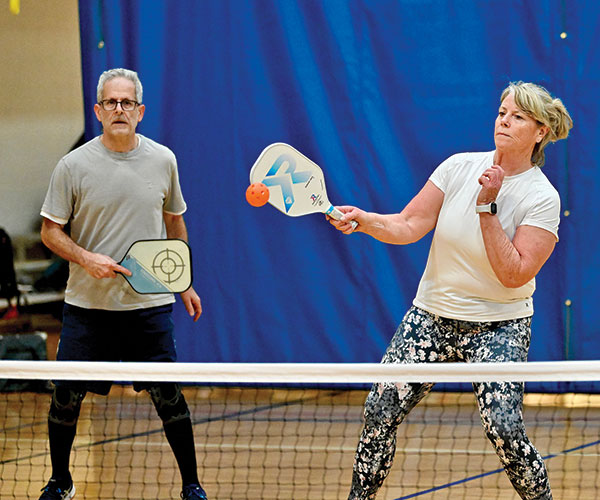Vince Bondar saw no reason to move from his Shaker Heights home after his wife’s death from cancer. But his three daughters — who live in Denver, Seattle and Taiwan — pressed their dad to think about moving to a retirement community. He told them firmly he was staying home, no matter what.
“This is where you have a tug-of-war between emotions and logic,” Bondar says. “We had been in that house for 40-some years. There were a lot of memories there.”
“This is where you have a tug-of-war between emotions and logic,” Bondar says. “We had been in that house for 40-some years. There were a lot of memories there.”
Bondar, a retired communications director of a large accounting firm, had the means to hire housecleaners and yard workers. But his daughters worried about his safety alone. His neighbors were professionals, so they were gone all day, leaving him isolated.
His daughters convinced him to sign up for an emergency response system that summons the police or an ambulance when the wearer presses a button. Bondar, healthy and strong in his early 80s, thought wearing the device around his neck wasn’t necessary, but he did it for his daughters. Then, one day while he was exercising in his basement, he fell. He had broken his hip and couldn’t move to reach the phone. He pressed the button, and within minutes, an ambulance took him to the hospital.
That was a pivotal moment in his decision to move to a retirement community.
“That’s when logic began to overwhelm my sense of emotion,” admits Bondar, who turns 88 this month.
One of his daughters came back to town to take him to visit retirement communities. He remembers driving up to one and refusing to get out of the car. He immediately sensed it wasn’t right for him. But later that day, they visited Hamlet Village in Chagrin Falls.
“I remember driving up the driveway and feeling like I was going up the driveway of some of the resorts that I stayed at many years during the winter months,” Bondar recalls. He toured Hamlet and later attended a party to make sure he related well to the other residents. He wanted a new place to live and still live it up — not simply fade away in his senior years.
He moved to Hamlet in 2003, into a spacious apartment with a spectacular view of the Chagrin River. He has the privacy of his own home and people around if he needs anything.
Once he got past the emotions of letting his house go, Bondar says, the move was a great relief.
Old age is like everything else, the adage goes. To make a success of it, you’ve got to start young.
That thought is often reiterated around the campuses of continuing care retirement communities (CCRCs), where seniors like Bondar often say they wished they had moved in much earlier, when they were younger and it was easier for them to get around and make a lot of new friends.
Seniors have long had a range of choices when they move out of their longtime homes, from senior apartment complexes to assisted-living facilities to nursing homes. Continuum of care communities put independent living, assisted living and nursing care on one campus, so that seniors don’t have to uproot themselves again when they need more care. Those who move to independent living when healthy can make friends who will still be on the same campus and can easily visit, even if they move to a different facility there.
That thought is often reiterated around the campuses of continuing care retirement communities (CCRCs), where seniors like Bondar often say they wished they had moved in much earlier, when they were younger and it was easier for them to get around and make a lot of new friends.
Seniors have long had a range of choices when they move out of their longtime homes, from senior apartment complexes to assisted-living facilities to nursing homes. Continuum of care communities put independent living, assisted living and nursing care on one campus, so that seniors don’t have to uproot themselves again when they need more care. Those who move to independent living when healthy can make friends who will still be on the same campus and can easily visit, even if they move to a different facility there.
Other senior housing communities call themselves “life-care communities,” which offer similar housing options but sometimes have different payment structures. Some life-care facilities require large payments to “buy in” to the community — from $20,000 all the way up to $400,000 — and guarantee care for life, no matter how long the person lives or how great his or her medical needs become. Other communities, such as Hamlet Village, have different levels of pay structure for each type of care and service.
While financial structures are important, the first step is for a family to decide what type of environment works best for an aging adult.
Last year, the first of 78 million baby boomers — born between 1946 and 1964 — turned 60. The aging population is also living longer these days, so more people are struggling with where to live in the last third of their lives.
“Most of the world wants to be at home,” says Lois Mahar, a geriatric care manager with the ElderLife Advisors division of the Visiting Nurse Association Healthcare Partners of Ohio (VNA).
Her observation is backed up by an AARP survey. “When asked where they want to live as they age, a full 90 percent say, ‘In my home,’ ” the study’s report reads. “They do not want to live with relatives, in a nursing home or at an assisted care facility. They want to live at home.”
For those seniors, home health care agencies that focus on geriatric patients can tend to their needs. The VNA’s ElderLife Advisors offer regular home visits by a nurse. Adult children living out of town often hire the VNA’s geriatric care managers, Mahar says, so they can rest assured that someone is watching out for their aging parents.
“They know the care manager is here,” Mahar says. “If there’s been an issue such as a fall, I’ve been in the emergency room with clients at night, providing the hospital the information and then communicating with out-of-town family members. It’s a great relief for them.”
Home health care can also help retirement community residents. While Bondar was recovering from another recent fall, he hired a home-health agency for one hour each day at his Hamlet apartment.
Many continuing-care communities provide an on-site geriatrician — a medical doctor who specializes in treating the elderly — or access to nursing care or physical therapy.
There are plenty of reasons to move into independent living while completely healthy, advises Dr. Matthew Wayne, a geriatrician and the chief medical officer for Eliza Jennings Senior Care Network, which has a continuing-care community called The Renaissance in Olmsted Township.
“A community really needs to meet your needs on multiple levels — your social wellness, your occupational wellness and your spiritual wellness,” Wayne advises. “If every decision you’re making is based on a perceived medical need, you may not end up being as happy as you may want to be.”
“A community really needs to meet your needs on multiple levels — your social wellness, your occupational wellness and your spiritual wellness,” Wayne advises. “If every decision you’re making is based on a perceived medical need, you may not end up being as happy as you may want to be.”
Social life is a major draw for seniors moving into Laurel Lake, a life-care community on 150 lush acres in Hudson that includes walking trails and three fishing lakes. Just drop in on a Wednesday or Friday to “The Pub” — Laurel Lake’s on-site bar — where happy hour starts at 4.
Given the sheer number of activities and parties, retirement community living can seem much like the fun of dorm life in college. Laurel Lake, like Hamlet, offers many social activities for seniors, including courses taught on site by Case Western Reserve University.
“This place lends itself to many of us living longer,” says Sally Davies, 76, who moved to Laurel Lake in 2004 after her husband died. “My blood pressure went way down when I moved in here. The stress is removed from my life.” Davies lives in a “villa” — an independent home with an attached garage and a glassed-in porch overlooking one of the lakes.
Retirement communities offer stress-free living because they typically provide services from plumbing to snow shoveling and landscaping. They offer several meal plans and, often, housecleaning services. Many offer choice and flexibility in a home’s interior design and services. Davies asked management to dig four flower beds for her because she enjoys gardening in the summer.
Tony Catalino, 73, moved to Laurel Lake in December 2006, even though two of his three daughters offered to move him in with them. But Catalino didn’t want to add more stress to his daughters’ lives. He also values the independence and social life at Laurel Lake. Catalino lives in an apartment there, and when he can’t sleep, he safely walks around in the common area — and always has someone to talk with.
Still, retirement community living isn’t for everyone. In some families, it works well for Mom or Dad to move in with an adult child’s family, often into an in-law suite. All three generations can benefit from bonding and learning from each other, not unlike “The Waltons.” The aging parents can receive daily care, if they need it, at an adult day program.
Other seniors, as the AARP study pointed out, prefer the comfort of the home they’ve lived in for decades. Bruce and Ann Wacker, who’ve lived on Cleveland’s West Side for 25 years, have looked at several retirement communities. But every time, they’ve walked away, realizing it’s just not the right environment for them.
Other seniors, as the AARP study pointed out, prefer the comfort of the home they’ve lived in for decades. Bruce and Ann Wacker, who’ve lived on Cleveland’s West Side for 25 years, have looked at several retirement communities. But every time, they’ve walked away, realizing it’s just not the right environment for them.
“I like our street. There’s kids around, and I think it’s a healthier neighborhood that way,” says Bruce, 80. “Life is not about old people isolating themselves from young people.”
He says neighbors often help him and his wife with snow shoveling. The couple are active and socialize frequently. Bruce usually plays bridge with friends once or twice a week.
The Wackers realize that some minor health issues and the sheer boredom of yard work may force them to downsize soon to a manageable one-floor condominium. But Bruce insists it will be in a neighborhood with a mix of ages.
When healthy seniors are deciding whether to stay at home or move to a retirement community, the bottom line, says Eliza Jennings’ Dr. Wayne, is to go with your gut feeling.
“My advice is to go visit,” says Wayne. “Go for dinner, take a tour, understand the culture of that retirement community, of that campus and see how it feels. If you just don’t feel comfortable, don’t force yourself to make a move.”
Vince Bondar agrees that there is no simple formula for deciding.
“You overcome this tug-of-war between the emotional things, the idea of moving. Everyone arrives at that place by a different route,” Bondar says. “There’s literally dozens of ways of getting to that decision. Sometimes it takes an accident, like mine, to make up the mind. In other cases, somebody just says, ‘I’m doing it because it makes a lot of sense.’ ”



